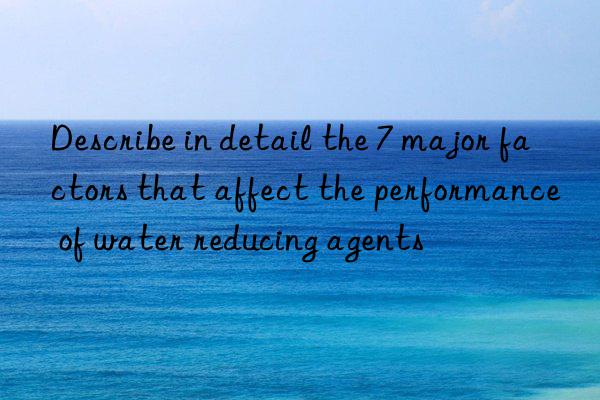
Because water-reducing agents are relatively cheap, can improve the workability of concrete, and have relatively good performance, they are widely used in industry. However, there is one problem that cannot be ignored. However, during testing or actual construction, there are some factors that will directly or indirectly affect the water-reducing agent. Next, the editor of Yulong New Materials Co., Ltd. will take you to see what factors are there?
1. Mud content of sand
When the mud content of sand is high, the water-reducing rate of the water-reducing agent will be significantly reduced. Unlike naphthalene-based water-reducing agents, which are generally solved by increasing the dosage, the performance of naphthalene-based water-reducing agents is not significantly improved when the dosage is increased. In many cases, the fluidity has not reached the requirements and the concrete has begun to bleed. According to literature reports, this is because the soil swells when exposed to water and forms a layer of adsorption with the water-reducing agent, causing the performance of the water-reducing agent to be lost
2. The influence of sugar retarder
At present, the main retardants used in water reducing agents are: sodium glucose, sugar, citric acid, etc. In industrial production, Aspergillus niger is commonly used to ferment sodium gluconate. However, if production control is not strict during the production of sodium gluconate, there will inevitably be residues of glucose and Aspergillus niger, which will inevitably affect the performance of the water-reducing agent at high temperatures. Make an impact.
3. Water consumption or dosage
Most concrete mixtures prepared with water-reducing admixtures are very sensitive to water consumption. Indicators that reflect the performance of concrete mixtures usually include fluidity, cohesion and water retention. In actual tests, terms such as exposed stone heaping, bleeding segregation, heaping and bottoming are usually used to describe the properties of concrete mixtures. state. Due to the lax control over the detection and control of aggregate moisture content in commercial concrete mixing stations, it is easy to cause excessive water consumption during production, leading to bleeding and segregation of the concrete mixture.
The water-reducing agent is sensitive to changes in its dosage. It has a saturated dosage, and the performance of the water-reducing agent is optimal at the saturated dosage. If the dosage is too small, the fluidity of the concrete will be low. If the dosage is too large, segregation, bleeding, and even bottoming will occur.
4. Influence of microorganisms
Microorganisms can grow mold on the surface of a certain polymer under appropriate temperature and humidity conditions. In a hot and humid environment, the secretions of mold will cause substances to decompose and transform into alcohols, organic acids and other substances. These substances in turn provide nutrients for the growth of mold, allowing mold to parasitize and reproduce, aggravating biodegradation.
5. Compounding technology
Compounding is mainly a mixture of water-reducing agent mother liquor and small materials. Water-reducing agent mother liquor refers to various functional mother liquors, such as pure water-reducing jellyfish. liquid, early-strength water-reducing agent mother liquor, water-reducing and slump-preserving mother liquor, etc. Small ingredients mainly include air-entraining agents, defoaming agents, thickeners, sugar and sodium gluconate, etc. In most cases, the required state cannot be obtained only by using the water-reducing agent mother liquor, and small materials need to be added to control it. For example, when the fluidity of concrete is poor, an appropriate amount of air-entraining agent can be added to increase its fluidity; when the concrete has many bubbles, a defoaming agent is added to reduce or eliminate them; when the concrete bleeds, a tackifier is added , can increase the cohesion of the slurry and solve the bleeding problem.
6. Effect of temperature
As the temperature increases, the movement of macromolecular chains intensifies, and chain thermal decomposition will occur, resulting in accelerated polymer degradation. Therefore, the water-reducing agent should be stored in a cool and ventilated place, and it is best to use the newly produced water-reducing agent as soon as possible.
7. Cement properties
1. Cement type and dosage: The chemical composition, form and production process of cement clinker will affect the effect of water-reducing agent.
2. Alkali content of cement: The alkali content of cement will have a great impact on the adaptability of the water-reducing agent. As the alkali content of cement increases, the adaptability of the water-reducing agent becomes worse, resulting in an increase in slump loss.
3. Fineness of cement: Cement particles have relatively strong adsorption to water-reducing agent molecules. In cement slurry, the finer the cement particles, the larger the specific surface area, and the greater the adsorption capacity for water-reducing agent molecules. The adsorption capacity is also greater.
4. Freshness of the cement: The fresher the cement, the worse the adaptability of the water-reducing agent to it. This is because the fresh cement has strong positive electricity and has a greater adsorption capacity for the water-reducing agent. . In addition, when concrete is prepared with cement that has just been ground and has not had time to lose heat, it is often accompanied by low water reduction rate and excessive slump loss. The higher the temperature of the cement, the less adaptable the water-reducing agent is to it, and the faster the slump loss of concrete will be.
The above are the main factors of water reducing agent performance</p



 微信扫一扫打赏
微信扫一扫打赏
